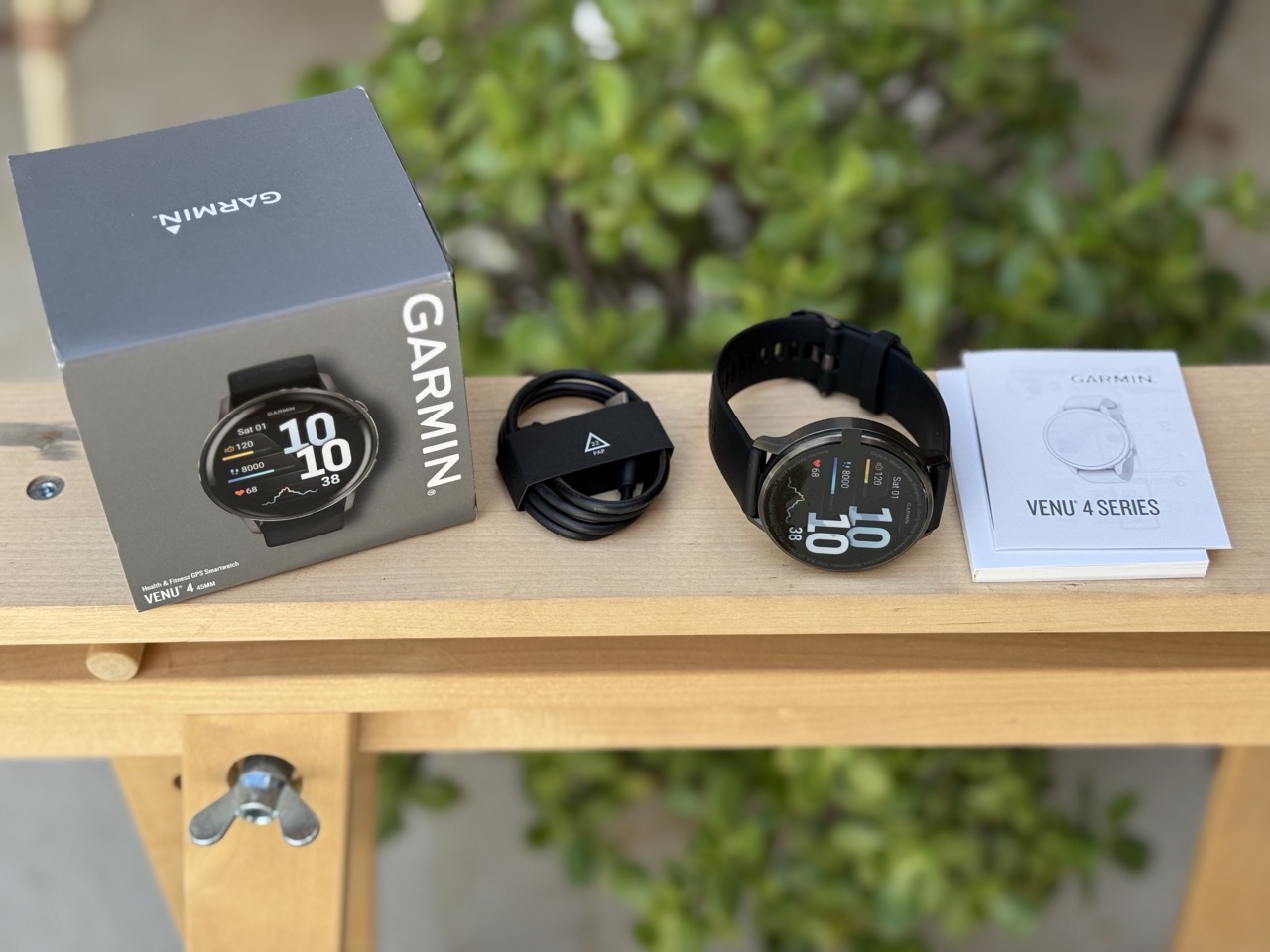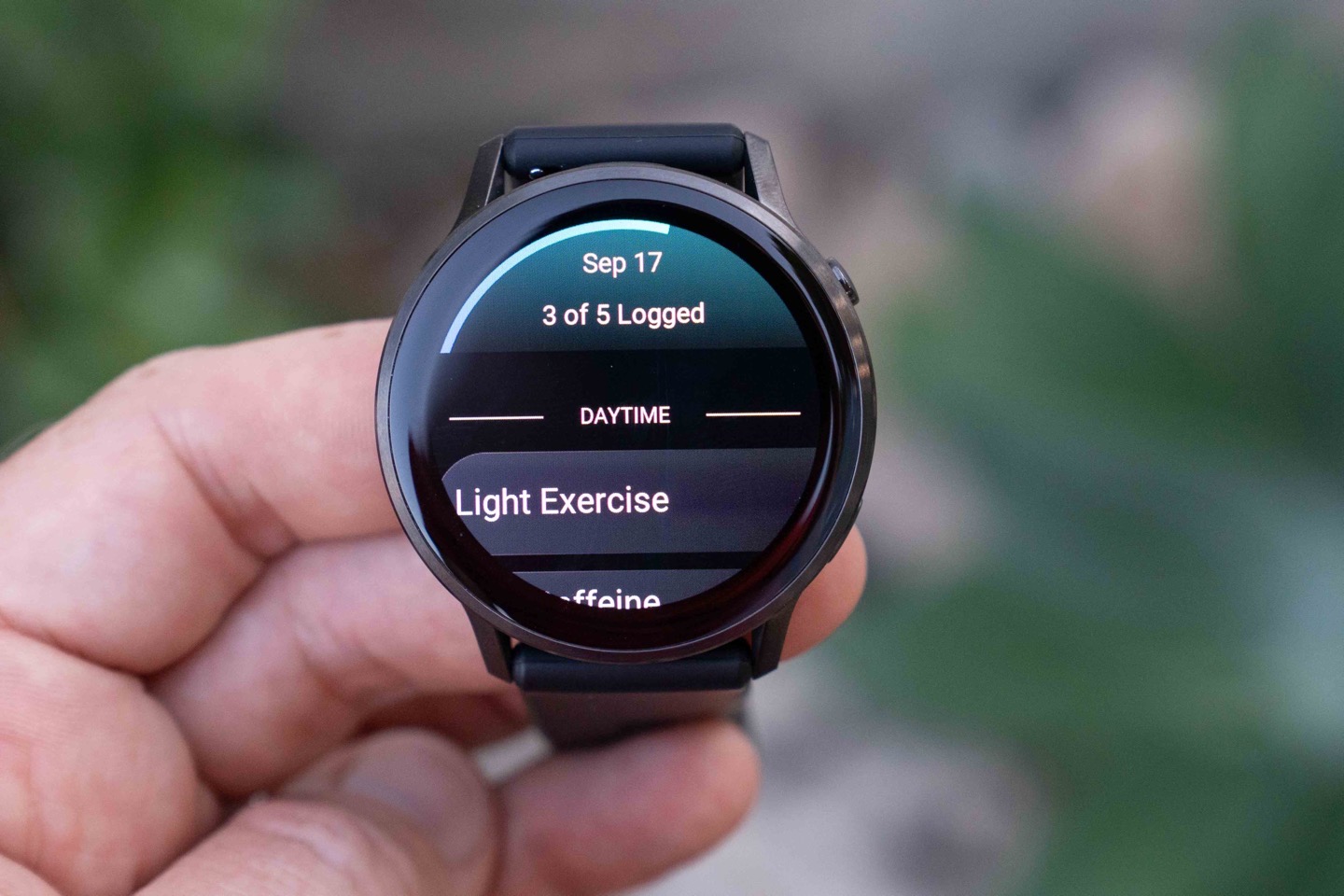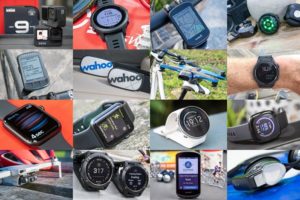
Garmin has just announced their Venu 4 & Venu 4S watches, which are their mainstream, but sportier, competitors to the Apple Watch, Google Pixel, and Samsung Galaxy Watch. And at first glance, based on the relatively thin marketing materials, these would seem to be a letdown.
However, in reality, this watch is actually just a Forerunner 570 with a different case, a flashlight, and ECG. That means it’s a massive upgrade over the existing Venu 3, whether you wanted it or not. This means a ton of new sport features, especially around running and triathlon, training load/status, as well as expanded sensor support, and a full metal case. Albeit, we lost a button. RIP button.
But it also has new-to-Garmin features too, primarily around sleep and health tracking, like Sleep Alignment and Lifestyle Logging. But it also adds a number of new accessibility features, including spoken watch faces, spoken health data, color filter options for color blindness, and more.
So, let’s dig into all the newness and how it compares.
What’s New:

The Venu 4 is a substantial upgrade over the Venu 3. Perhaps the most notable thing out of this entire list is the least flashy: It’s now on the same shared ‘Garmin OS’ platform that most other 2025 watches are using, including the Fenix 8/8 Pro, Forerunner 570/970, and Venu X1. But that doesn’t mean it has every feature; rather, it just means that it’s finally sharing a common underlying OS. So new features can be added more quickly across all units, which should improve quality (rather than each team doing their own dance).
In any case, here are all the new features compared to the Venu 3, though I’m frankly probably missing a bunch of tiny new settings and such, given the platform shift.
– Added LED flashlight (white & red)
– Increased display brightness/nits (matches Forerunner 570/970 displays)
– Added multiband/dual-frequency GPS/GNSS
– Added spoken watch face (for accessibility)
– Added spoken health data (for accessibility)
– Added color filter option (for color blindness accessibility)
– Added new Sleep Alignment feature (circadian rhythm tracking)
– Added new Sleep Consistency feature
– Added Smart Wake Alarms
– Added Lifestyle Logging on-device (plus all users get on Garmin Connect)
– Added Health Status on-device (plus all users get on Garmin Connect)
– Added full Training Load suite (Acute Load, Recovery, etc…everything!)
– Added Training Readiness (and all underlying metrics)
– Added new sports/workout profiles (listed below)
– Added Auto Track Detection
– Added new Mixed Session (sport profile)
– Added AutoLap by timing gates
– Added Suggested Finish Line estimates
– Added Load Ratio
– Added Projected Race Time predictor
– Added Heat & Altitude Acclimation
– Added Evening Report
– Added Garmin Triathlon Coach training plans
– Added structured multisport/triathlon custom workouts
– Added Focus Modes
– Added Large Font UI Option
– Added new sensor types: Added Extended Display, Club Sensors, inReach, Shifting, Shimano Di2 (previously had: HR, Headphones, Speed/Cadence, eBike, Lights, Power, Radar, Smart Trainer, Footpad, Tempe)
– Added support for up to 4 CIQ data fields concurrently (versus 2 previously)
– Consolidates to Garmin’s standard underlying firmware platform for Venu/Fenix/Forerunner 2025 watches (Garmin OS)
– Added metal case (previously just metal bezel)
– Removed third button for funsies
– Decreased battery life slightly on larger unit (smaller is same)
– Still offered in two sizes – 41mm and 45mm
– Increased price by $100 to $549 (was previously $449)
Now, on that pricing piece, I pushed back a bit on a discussion with Garmin about it, asking why there was a $100 price increase. Ultimately, they said that the Venu 4 unit is essentially a choice of whether a user wants a touch-first watch (the Venu 4), or a button-first watch (Forerunner 570). Both are priced the same, except the Venu 4 has ECG whereas the Forerunner 570 doesn’t.
They noted that while sportier people want that button-first approach and the sporty look of the Forerunner series, many more mainstream folks want a sleeker metal-encased look of the Venu 4.
The bigger question though, gets into leaving a substantial pricing/market gap at the previous $400-$450 price range that Apple/Google/Samsung occupy with their very capable fitness watches. More on that later on.
Some Early Thoughts:

Even if Garmin itself doesn’t make it clear in their own marketing materials and site, there’s no question this is a massive upgrade over the Venu 3 (with a huge increase in features, especially for sportier folks). It’s literally a Forerunner 570 with ECG, a Flashlight, and a few lost buttons. All for the same price. With the big codebase merge behind the scenes, the users are the biggest benefactors in terms of not just tons of new features they might not have otherwise gotten, but hopefully also software stability. While this past summer was rough (at best) for most of these new devices as that merger happened, at this point, things seem much better.
The challenge though, isn’t that Garmin has delivered a ton of value in this product (at least, ignoring the lack of maps). Instead, it leaves a really odd and big-sized gap for all their competitors to play in. Garmin has effectively abandoned the $400-$499 price range that is the most popular realm for mainstream watches. Sure, they have Instinct and a few others floating in there, but those aren’t the same customers (else, Garmin wouldn’t have 2,318 models).
And while they have the Vivoactive 6 with many core Venu features, that sits at $299, so effectively undercutting not just their competitors, but also honestly undercutting Garmin’s own Venu 4 products as well. Previously, you could make the case to pay an extra $100-$150 for certain Venu 3 features. Now, making the jump nearly twice the price seems tough.
Garmin will probably grumble that I always complain about price. And sometimes, that’s true. But inversely, the also-announced Garmin Bounce 2 today saw a price increase, but that one is frankly very justifiable. The original Bounce 1 LTE was always priced bizarrely low (in a good way, obviously), floating around $125-$149. Now, at $299, that’s the same price Apple is charging for their Apple Watch SE cellular, which has the kid software/experience wrapper. And while these two watches are different, I think Garmin competes very strongly for the younger child demographic, especially.
Anyways, we’ll have to see how the market reacts here (in terms of sales). As I noted in the video, the product execution itself is quite good – I just remain unconvinced on the reasoning for having a massive price gap in their lineup.
Nonetheless, more to come. With that – thanks for reading!
Found This Post Useful? Support The Site!
Hopefully you found this review/post useful. At the end of the day, I’m an athlete just like you looking for the most detail possible on a new purchase – so my review is written from the standpoint of how I used the device. The reviews generally take a lot of hours to put together, so it’s a fair bit of work (and labor of love). As you probably noticed by looking below, I also take time to answer all the questions posted in the comments – and there’s quite a bit of detail in there as well.
If you're shopping for the Garmin Venu 4 or any other accessory items, please consider using the affiliate links below! As an Amazon Associate I earn from qualifying purchases. It doesn’t cost you anything extra, but your purchases help support this website a lot.
And of course – you can always sign-up to be a DCR Supporter! That gets you an ad-free DCR, access to the DCR Shed Talkin' video series packed with behind the scenes tidbits...and it also makes you awesome. And being awesome is what it’s all about!
Thanks for reading! And as always, feel free to post comments or questions in the comments section below, I’ll be happy to try and answer them as quickly as possible. And lastly, if you felt this review was useful – I always appreciate feedback in the comments below. Thanks!

























Wow, $300 for a kid watch seems very high, but you’d have a better idea of it’s utility having had them on Bounce 1.
Kinda low compared to the other $550+ watches they are releasing today. Also shows that they can still make money with $300 Forerunner like watch with LTE.
I am actually pretty satisfied with bounce 2, outside of battery life being in the realm of 1 day being the opposite of what any of us would want for a kid watch. Give it at least venu 2s battery life (5-7 days) and then we’re talking for the $300 price.
“Garmin will probably grumble that I always complain about price”. Hilarious. Do they not think that echoes common sentiment? It’s the number one thing I see other people mentioning as well.
+1
Price of the current watches not the *only* thing but it is the *main* thing why I still have a VivoActive 4s on my wrist.
Pricing is £470 UK – Venu 3 was £450 (when I bought) in August 23. Not a huge jump (but still going the wrong way).
I suspect the increase in US price is tariff-related.
Yep, seeing this with quite a few companies. Raising the pricing on all markets, no doubt to off set the tariffs of US imports, to keep profits up.
If only other countries could make product, instead of primarily the US.
The prices are going up in other countries that honor their free trade agreements. Garmin manufactures in Taiwan so Taiwan to 3rd countries shouldn’t be seeing the tariff based hikes.
I’ve seen it in Sweden for 4990 SEK roughly €450.
I get the feeling that Garmin is spreading that pain across all of the markets to avoid killing their US market share.
For Apple users, I don’t know who would buy this watch over an Apple Watch SE 3.
Garmin’s pricing has gone completely out of whack and they are in trouble.
I’ve been struggling to decide on which watch I should upgrade too.
My 255 is still going strong, but just feel I need a change and that I’m missing out on some newer things.
Garmin’s lineup continues to confuse me further (and increase my decision paralysis). Ahhhhh!
255 is still the best watch out there if you want battery life (=MIP) and reasonable price…
I have f8, still wear 255s on a daily basis. two things i miss from f8 on 255s are the torch and the phone calls from the wrist. If 540 had a torch, I might consider.
Is the Venu 4 keyboard still the T9, or is it a full keyboard? And thanks for all your in-depth information on Garmin devices.
Is there anything Garmin are doing like the AF history that Apple
can do?
In Germany the Bounce 2 becomes totally uninteresting in taktile to its competitors from XPLOra. This are now on sale for 69 to 89€ with a monthly fee of 6,99€.
Even the listed price of 185€ was ok par with the 180€ Garmin wanted us to pay. Those watches deliver the same features I think.
Bounce was never interesting here in Germany because of its high price (especially for the old model wich had quite some age)
As per Garmin website Venu 4 is 45mm in diameter and Forerunner 570 is 47mm. In the YouTube video you have put 46mm for Venu 4 and 45mm for Forerunner 570…
All in all, Venu 4 seems to have best case dimensions-to-screen diameter ratio of all Garmin watches… especially being only 12mm thick.
Yeah, didn’t catch that single digit typo. :(
These prices are crazy. This seems to not really be about marketing or value, although that is how they explain it. They ARE making watches with more features, as is every other watch maker, but the tech is just getting better (and cheaper). They are simply raising the prices of all their watches by 20 to 40% and now want to charge for new features in Garmin Connect. Over $500 for a watch without maps (Garmin’s real strength) is absurd. I will no longer consider a Garmin watch (at least a new one).
Really? 10 times?
Are there pace-based DSWs for running? The compare feature on the U.S. website lists only hr-based
Yes there are pace-based DSWs
can anyone else confirm this as well? i’m still getting comments from other folks that there aren’t pace-based DSWs so want to verify
As these prices rise, it becomes clear to me that all I want is a good fitness/health tracking band like the polar loop and a mechanical watch. Replace the former every few years for under $200 and keep the ladder for decades.
I have a Venu 3 with extra bands I like and extra charging cables. Will these bands and cable work on the Venu 4?
Yes the bands and charging cables are interchangeable.
Wow, weird to bump the price outside of the pixel and apple watch segment! They were the fitness oriented direct competitor. And the big watch dropping battery life makes no sense, I specifically bought the Venu 3 for the battery life and the mid-tier sports watch as a pixel watch alternative.. hmmm :/
Replying to myself… I expected a small price jump btw, and would have instantly bought the upgrade to Venu 4 over my current Venu 3. But now, not so much… I don’t see the new features as being worth the upgrade tax.
Before buying Venu 4, potential customers should be aware that Garmin will probably abandon them and break some of the advertised features (such as Google Assistant integration and phone calls) months before it releases the next generation product, just like it did to Venu 3 owners.
Do it also have a resume later function for walking? Lets say I’m walking to my work in the morning pause my activity and in the afternoon I walk back and I want to start the same activity instead of recording a new one. My Venu 2 will save my first activity after a period, so I always have to record 2 activities.
According to the manual the Venu 4 has a ‘resume later’ option. Just like with the Forerunner and Fenix watches. So I think you can save your activity as one.
Correct, it does.
I just received and took a phone call on my Venu 3? I am at current version 16.05.
All these amazing watches, and subsequent, multiple, ‘bug’ firmware releases in the days that follow release. Garmin seems to not have the ability to release devices, without significant bugs.
Yet here we are, 5 years on from the release of Apple Silicon, and 11 months from there being no Intel software in macOS, and still Garmin hasn’t updated their Express software to at minimum, Universal.
I imagine they want us to use only Connect to update maps, but as that process is incredibly slow, they need to rethink that.
For a device that is a health ‘wearable’, taking it off for 6 hours to update maps (2Gb Internet) is unconscionable.
I was surprised Venu 4 did not get LTE.
Its usually the model to get more of the Smart Watch connectivity features.
This (minus flashlight) should have been a software update for Venu 3. Garmin is doing old Nokia tricks from symbian era, and we all know how it ended. They only protect their margin. As A Venue 3 user, I see no real reason to upgrade to the same Elevate 5 system. I would rather expect my watch received those updates considering it’s initial premium price.
Yes, exactly, M3k3m also remembers what Nokia was doing all those years ago.
They had so many phone models with the same hardware and only differentiated them at different price points by enabling or disabling software features.
The only way you could get all features was to buy their most expansive top end phone.
And look what happened to Nokia.
The updates are based on the new unified codebase. Venu 3 is old codebase. If they were to create these new features for Venu 3 they would have to do the same for each separate watch model (through a dedicated team, as they were doing in the past)
Ray – did you get to try the new Google maps app? I am not sure why it’s in the list of features on their site, it’s now in the connect IQ store for other watches too.
It’s nice that they added the full training load suite, it was a big gap for cycling in the Venu 3 (unless you recorded on both Edge and watch).
Appears to offer ‘bread crumb’ course capabilities akin to the latest Vivoactive (as one would expect at this point in their respective life-cycles)
Great review as always. but I’m still not seeing anything that’s going to pull me away from my 735xt.
You’re getting great value out of the 9yr old model watch.
If it works, stick with it.
When you do upgrade, look at a Garmin model that’s a few years old and half price.
I’ve had this 735 for many years and it’s worked for me on 10+hour MTB events, plus some tri’s up to HalfIM. Even after trying an Instinct2Solar and AppleWatch, I don’t find that I care about new features on a watch, but I’m always curious when a new review comes out.
735 Was still good here after 5 years.Only switched to Venu 2 because of old and readability. GPS bothered me since, as well as missing recovery and training impact and the like.
But now being with an X1 made me forget those sorrows and end the stages of grief cycle over the 735. Cherish yours….
old= OLED
So close to being a Forerunner. Just needs the extra buttons and swim features. They’d do well to consolidate. Expect more ‘which model should I buy’ questions.
That then makes it a FR570 :)
But with a flashlight and ECG.
That Forerunners are so close to lifestyle watches says volumes about who Garmin is targeting these days.
Accidently touched the reply.
But No, the 570 adds way too much bulk, those 2mm diameter and the thickness give almost 20% more bulk, which makes it incomparable on the wrist.
And all those buttons ;-)
I have lifestyle logging in the Connect app, but not health status?
I have a Forerunner 955
Will I be getting both in due course, I noticed health status showed as beta in the video?
Will there be a review soon on the Bounce 2 ?
The Bounce Ultimatum
I would love to see a Bounce 2 Review, even a mini one (no pun intended). Seems like it could help the next generation of athletes delay the use of smart phones a little longer and wondering if its woth the upgrade over Bounce 1.
Any idea if the Venu 4 has a way of calculating VO2 Max when doing indoor rides on a Wahoo or Tacx Trainer?
The Venu 3 couldn’t, you also mentioned that in your Venu 3 review…
Despite stating so in their own manual.
In one video in youtube of Garmin venu 4, there was info about new Garmin Fitness Coach ? Is it available , because you dont mention it
Fitness Coach or Sleep coach?
There are a few tweaks to the sleep coach, in terms of a new data page or two, though, I show those within the video around sleep consistency and such.
I’ll be updating the post above today with more photos/details though.
I guess he means Garmin Run Coach, Garmin Cycling Coach and Garmin Triathlon Coach which most “consumer” watches from Garmin don’t support so far.
link to garmin.com
The page that you linked literally describes Garmin Fitness Coach though? Maybe it didn’t a week ago, when you posted that.
Seems like it’s similar to the other 3 Garmin __ Coach plans that you mentioned, except it’s an adaptive plan focused on cardio workouts, with optional strength workouts.
Here’s a Garmin page that’s dedicated to Garmin Fitness Coach:
link to garmin.com
“Get a personalized plan based on your fitness, activity history and background information. This includes a variety of time duration and heart rate-based cardio workouts that vary in intensity plus optional strength workouts. Don’t want a plan that centers on one activity? Sure thing. Garmin Fitness Coach supports more than 25 activity types, so it can seamlessly adapt to your lifestyle. It also adjusts based on your health and workout data. For example, if you had a great night of sleep, a tougher workout may be coming your way.”
I can’t find any info on what watches are supported, although I can say that my FR955 doesn’t seem to be on the list.
Have strong feeling Venu 4 will get a proper succesor with Elevate 6 (Venu 4 plus?) and actual new features (not software tweaks) within 1 year. With new metrics related to blood pressure on watches like Apple one, they are not competitive at this price point. Venu should be a watch for general audience and garmin, overall, should have true software support and not only till next gen is released.
Is there any actual indicator of a gen6 sensor on the horizon? The internet only has people speculating on reddit. Some seem to have hoped to see gen6 on the fenix 8 pro, but that didn’t happen…
Gen 5 has been with us since April 2023, so, at some point, there will have to be newer tech.
Does the Venu 4 have drill mode for swimming?
I was waiting for the venu 4. I was in doubt if I should go for the Venu 4 or the forerunner 970. I think I will pay that extra money and go for the 970, I would love to have all the navigation options with maps. I was hoping they would put maps in de Venu 4….!
As an older person, what’s the least expensive way to get the EKG function?(which requires Elevate V5?)
Thanks!
Epix 2 Pro?
Used Fenix 7 or Venu 2S?
@Angstrom: Cheapest would probably be a Venu 2+, if you can find one. Incidentally, Elevate 5 is not required for ECG – the Venu 2+ has ECG with only the Elevate 4 (albeit it is the only watch Elevate 4 that does ECG, all others do it with the Elevate 5).
@MartinM: Venu 2 and 2S do not have ECG.
What is the best buy for health care smart watch specifically with
ECG? Venu 4 is disappointment!
Can someone explain to me , if now that the Venu use the same base as Forerunners and Fenix why the hell after one year my Fenix 8 its way laggier and slow than this Venu 4 ? I don’t care about the colours ?the visual effects and other beings I want that smoothness !
When a RUNNING test?
We need a Bounce 2 deep dive asap. My youngest loves her Bounce 1. And nice work Garmin sucking kids into the Garmin ecosystem early on.
Does the V4 really have 4 CIQ field support since the 570 doesn’t? That would be impressive, that the V4 surpasses the 570 here.
The 570 has it too though.
Nope. Try adding a 3rd CIQ field. It will show 2 of 2. You can add multiple copies of the two you’ve already installed to a different page or field on the same page but you can’t add a 3rd. At least not on mine. I just tried.
I had a chance to play with an actual V4 and it does only support 2 CIQ DF’s, just like the 570. This doesn’t impact many, but for the few it does, it’s a pretty big deal.
For me, this is finally the no-compromises upgrade for my Vivo 4. Love the full suite of running and training stats in a lean and classy case. And fortunately, I’m not in a major rush to upgrade, so the price may come down before the time comes. Either way, it’s a pretty small expense relative to gym memberships, shoes, etc.
Are you expecting wireless charging on any Garmin watches in the future? I thought that might have made sense when they were waterproofing F8 for diving or with these maybe more “lifestyle” models too
Thanks for the review, but what i am always missing is a kind of Assessment of battery life in the long term. Or, in other words, how well will the battery still perform in 3-4 years?
After unfortunately losing my Instinct 2x Solar, I am considering which one to buy now. Instinct 3, Venu 4, Fenix E? All watches in the same price range, all of which are interesting. But £600 for a watch that will only have 60% battery capacity in 4 years would really not be worth it. So it would be great to gather some user experiences, as Ray doesn’t use the watches for long enough to give a realistic picture.
Does anyone know if this would work well for regular use while pool swimming, e.g., is the screen easily touch locked during a swim activity. Relatedly, do these buttonless Garmin’s do ok in water without activating phantom touches to the screen, etc.? I’m interested in this form factor but also use the buttons on my Fenix heavily for swimming and not sure how it will go from 5 -> 2 buttons.
Not sure why you would buy a 570 if this has the same features but with the addition of a flashlight and ECG. Unless you really want the form factor and five buttons of the 570. Plus it’s aud $50 cheaper than the 570 here in Australia.
We’d need to understand if at least the GPS accuray + HR are the same as 570.
It would be nice to have a running test fomr our RainMaker.
Do you think he’ll give us a deeper review of the Venu 4?
In terms of on-land GPS accuracy, in all my runs and rides thus far (including in the mountains/trails), I’m not seeing any differences to the FR570 (or to the Fenix 8 Pro for that matter). Perfectly accurate.
Thanks a lot Ray. Will be my probable next Garmin, leaving the “old” Forerunner 645m.
Just waiting for a price-drop.
– Enrico
PS
I noticed you generally do not consider Huawei & co. sport watches. Is there a specific reason?
Thanks a lot Ray. Will be my probable next Garmin, leaving the “old” Forerunner 645m.
Just waiting for a price-drop.
– Enrico
PS
I noticed you generally do not consider Huawei & co. sport watches. Is there a specific reason?
Opps, missed this.
Huawei watches simply don’t get much interest around here, especially from North America where you can’t buy them.
I’m really excited about the watch! Ray, could you please cover the practicality of operating it with only two buttons in wet conditions – such as running in the rain or during open-water swims – in your in-depth review?
Same request, more concise than my question above! Thanks Ray
I’ve got an openwater swim slated for it Friday. I’ve been using it on other water activities (snorkeling/etc…), but more just general usage than actual swim-focused bits. On the to-do list.
Is there a snorkeling activity ? Like the “mermaid” mode for the Suunto ?
I probably already know the answer to this, but since Garmin has moved the Venu 4 to the same OS as its other recent watches, does that mean that it has also eliminated the one feature that is present on the Venu 3 that I really like? Namely, the Venu 3 allows me to choose whether the watch screen applies adaptive brightness, while newer Garmin watches (like my Fenix 8) force adaptive brightness upon the user. This feature on the Venu 3 has been very useful for me, as I need a bit more brightness to read smaller print. In dim light, my Fenix 8 screen is too dark for me to read easily (and many others have echoed this sentiment). In my attached image, you can see the autodim feature that can be turned on or off on the Venu 3 (left), but not on the Fenix 8 (right). I will be sad if this option is gone on the Venu 4
Boy I went to the Venu 4 from the Venu 3 and notice that when working out in the streets in the dark the watch is dimmer? Now during the day it’s brighter. Like you I have a harder time seeing the smaller watchface items like floors climbed at a glance when it’s dimmer. At the moment I can find any setting to make it always bright?
Yep. Unfortunately Garmin seems to force you into auto-brightness now. I too have issues with the brightness being too dim in low light. It’s always just fine in bright light. I always keep the brightness level set to max because of this, which is a shame because it doesn’t need to be that bright other times and chews up a lot of extra battery.
sleep alignment/rhythm is very interesting. At least I have started noticing much steeper body battery inclines when sleeping before a certain hour than after.
So I am not having that now, hopefully in a firmware update.
I was stoked in the rumor phase of the upcoming 570/970 watches. Because of the delay in online ordering I got to see those in store first and I was totally put off by the BULKiness, coming from a Venu 2 after a 735XT.
Now having to choose a new Forerunner or Venu, I stick with the Venu X1, without any hesitation. The sleep alignment/rhythm will come, I am sure
The screen and the thinness provides perfect wrist comfort. Assuming the X1 will be perfect for at least 5-7 years, considering the 735 was still good after 5 years.
Hi Ray
Thanks for this post.
Are you planning to do an in-depth review of the Venu 4?
Krgds
Ed
YES, PLEASE RAY!
=:)
I am. Just trying to figure out which review to finish first (Fenix 8 Pro, Venu 4, or the long-awaited Venu X1 review, given I had that on my wrist all summer long).
Fénix 8 Pro please 🙏🏻
May I vote?
Really really?!
=;P
As long time Garmin user I am very disappojted. Basic functions do not work properly.
I constantly get a very low heart rate during cardio workouts.
Sometimes it is around resting heart rate so I am sure it is wrong.
The heart rate measurements are in general often wrong on this watch.
It also already froze twice mid workout.
I recommend to wait until Garmin publishes a serious software update or try a competitor’s watch.
Yo
My wife just bought a Venu 4. Upgrading from 255s.
She really wanted Swim Training function. She checked with Garmin before buying and they said it did
NOT have swim training.
However she bought and guess what it DOES allow swim train sessions to be created
in Garmin App and uploaded to watch!!
She again contacted Garmin to highlight this and they again said sorry it does not have the function.
Thought i had better highlight before they realise they made a mistake and remove functionality.
The Venu 4 is also a running watch; it has as many or more features than the Forunner 265, and almost the same as the 570.
That said, how does it perform on a run with only two buttons and a touchscreen that, according to reports, activates in the rain or when wearing clothes.
How do I fix this? Apparently, the screen lock also locks the buttons, which doesn’t make sense. Does this mean that during a run, to change laps, pause, or finish the run, I have to unlock it first? I don’t think it’s practical.
Does anyone have experience running with it in rainy conditions, or with long sleeves that cover the watch? Thanks.
Locking and Unlocking the Device
You can lock the device to prevent inadvertent screen touches and button presses.
NOTE: You can customize the controls menu (Customizing the Controls Menu).
Hold Line drawing of the watch with a top button callout to view the controls menu.
Select Lock symbol.
The device does not respond to touches or button presses until you unlock it.
Hold any button to unlock the device.
Do you know where to find the lug-to-lug size, for the Venu 4 or for any other Garmin watch? Garmin should publish it officially: For me (male with small wrists), it is more rellevant than just the diameter when choosing a watch size.
Any chance to have a full review anytime soon?
YESSS, please!
Hi Ray, quick question on the new Sleep Alignment feature.
My Venu 4 shows my “actual rhythm” as 18:00–02:00, but I normally sleep 22:00–06:00. Do you know how Garmin is actually calculating those rhythm times, and did they give you any more technical detail on how this feature works in practice?
Also curious: what kind of sleep alignment window does your own unit show?
Thanks!